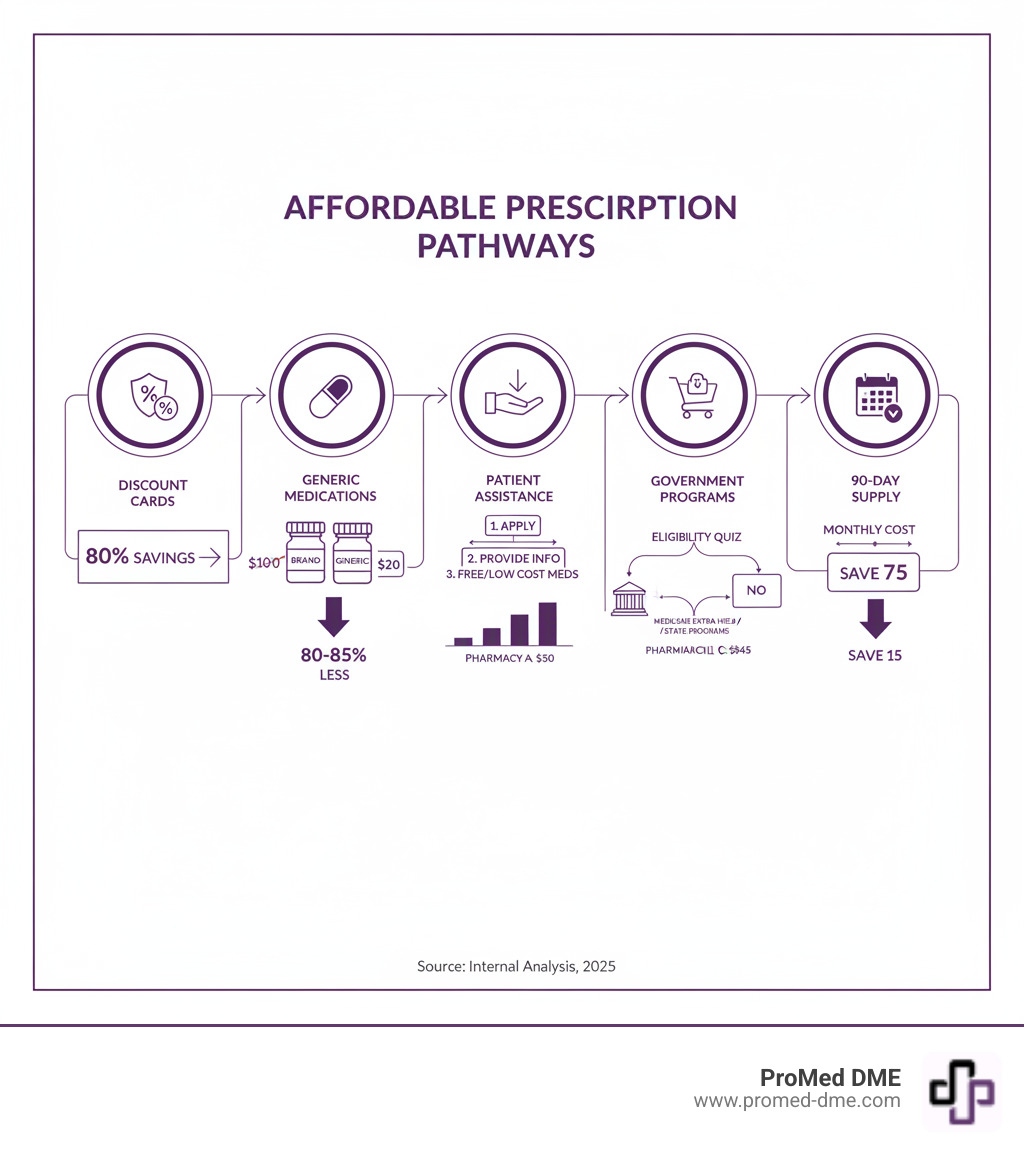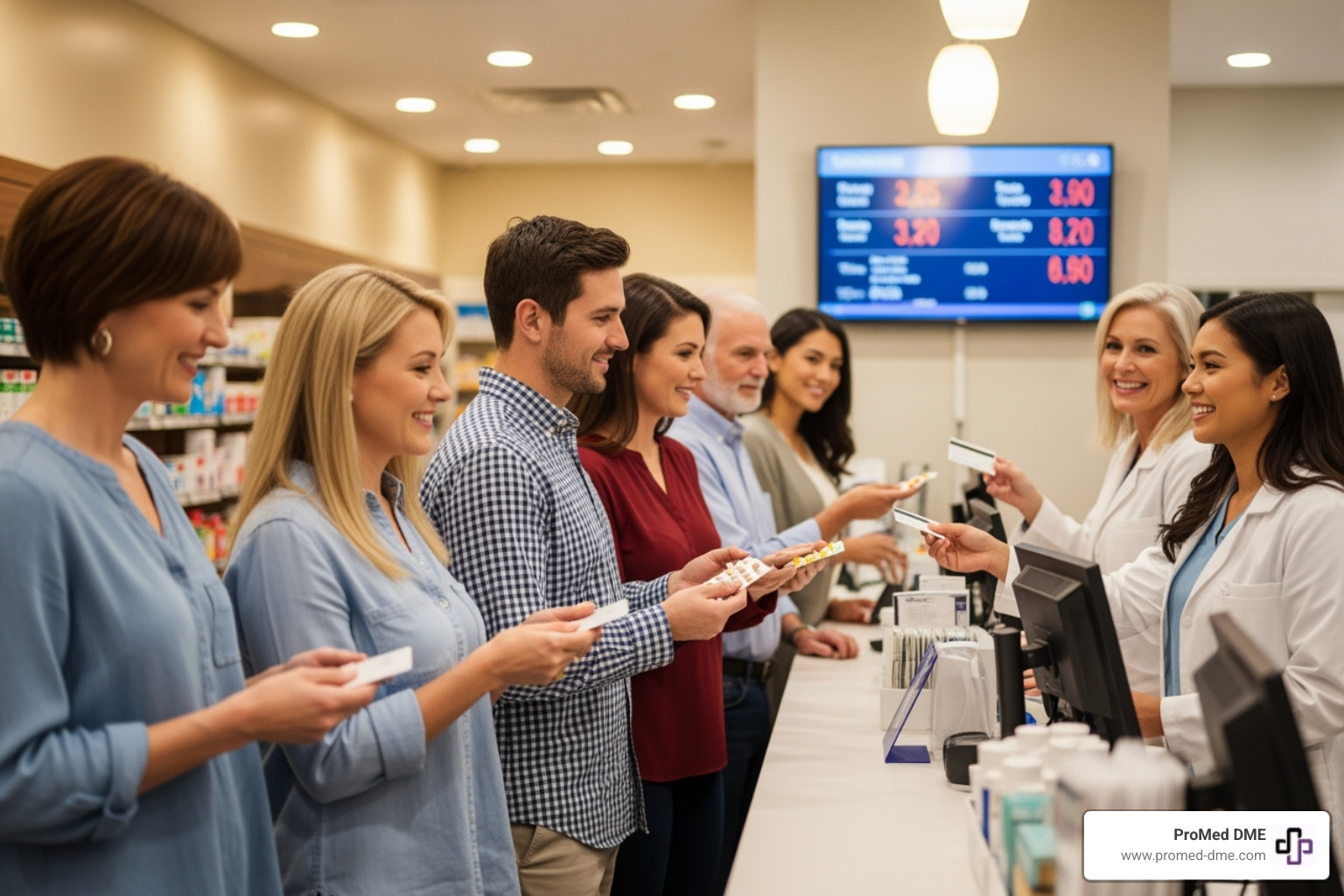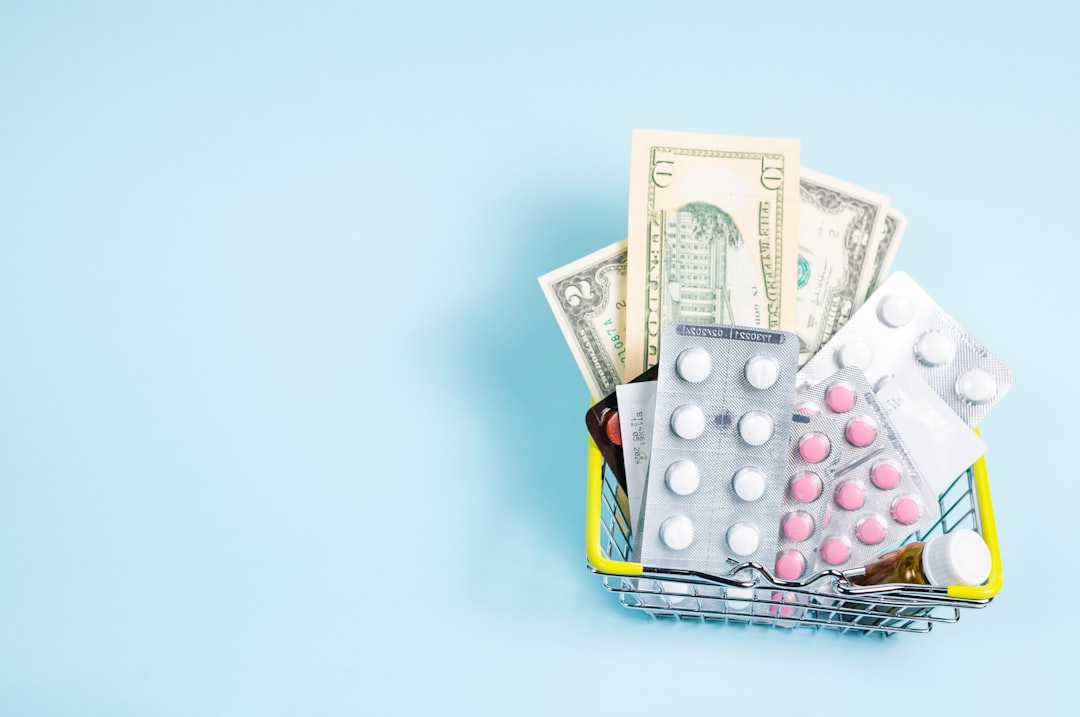Help with Drug Costs: A Comprehensive Guide to Affording Your Meds

Why Prescription Drug Costs Are Rising—And What You Can Do About It
How to pay for prescriptions can feel overwhelming as prices keep climbing. If you're struggling, you're not alone. In the United States, prescription drug costs averaged $1,114 per person in 2021 and continue to rise faster than other healthcare costs, creating real hardship for those managing chronic conditions.
The good news is you have more options than you might think. Here are the main strategies for affording your medications:
- Use prescription discount cards (e.g., GoodRx, WellRx) to save up to 80%.
- Switch to generic medications, which cost 80-85% less than brand-name drugs.
- Apply for patient assistance programs from drug manufacturers for free or low-cost medicine.
- Compare prices between pharmacies, as costs for the same drug can vary significantly.
- Access government programs like Medicare Extra Help or State Pharmaceutical Assistance Programs.
- Visit free or low-cost clinics if you're uninsured.
- Buy 90-day supplies to reduce per-dose costs, often through mail-order pharmacies.
This guide will walk you through each strategy for reducing your prescription costs. You don't need to be a healthcare expert to save money—you just need to know where to look.

Understanding Your Prescription Costs
Before exploring how to save, let's break down what you're paying for. Understanding these terms is key to figuring out how to pay for prescriptions affordably.
- Deductible: The amount you pay out-of-pocket before your insurance begins to contribute. If your deductible is $500, you pay the full price for prescriptions until you've spent that amount.
- Co-insurance vs. Co-pay: After meeting your deductible, you'll pay either a percentage of the cost (co-insurance, e.g., 20% of a $100 drug is $20) or a flat fee (co-pay, e.g., $10 for a generic, $40 for a brand-name drug).
- Drug Formulary & Tiers: This is your insurance company's list of approved drugs, organized into tiers. Tier 1 (generics) has the lowest co-pays, while higher tiers (brand-name and specialty drugs) cost more.
Understanding these basics helps you spot opportunities to save.
The Role of Generic Medications
One of the best ways to save is by choosing generic medications. According to U.S. Food and Drug Administration research on generic drugs, generics must have the same active ingredients, work the same way, and meet the same high-quality standards as their brand-name counterparts. The FDA requires proof that they are bioequivalent, meaning they deliver the same amount of medication to your bloodstream in the same timeframe.
The key difference? Generic drugs typically cost 80-85% less. A drug that costs $80 under a brand name might only be $10 as a generic, with the exact same therapeutic effect.
This price gap exists because brand-name companies spend billions on research, development, and marketing. Generic manufacturers don't have to repeat those expensive clinical trials, and they pass the savings on to you.
Asking your doctor for generics is a simple way to lower your costs. Your pharmacist can also often substitute a generic if your prescription allows it. This single switch can dramatically cut your medication expenses.
Why Are Prescriptions So Expensive?
If you've ever been shocked by a pharmacy bill, you're not alone. Here's a quick look at why costs are so high in the U.S.

- Manufacturer Pricing: Unlike in many other countries, the U.S. government doesn't regulate drug prices, giving manufacturers freedom to set high costs, especially for new drugs without competition.
- Complex Supply Chain: Wholesalers, pharmacy benefit managers (PBMs), and distributors each add their own markup as a drug moves from the manufacturer to you.
- Research & Development (R&D) Costs: Developing a new drug is expensive, costing billions and taking over a decade. However, critics argue this doesn't fully justify why Americans pay so much more than people in other countries for the same drugs.
- Insurance Negotiations: Your insurance company negotiates prices, but these savings don't always get passed on to you, especially if you have a high-deductible plan. Sometimes, the cash price with a discount card is even lower than the insurance price.
According to Kaiser Family Foundation research on drug costs, this spending continues to outpace other healthcare costs, making it essential to learn how to pay for prescriptions affordably.
How to Pay for Prescriptions When You Don't Have Insurance
Facing prescription costs without insurance is challenging, but there are practical solutions. Millions of Americans manage their medication expenses without traditional coverage by using discount programs, manufacturer assistance, and community health services. Let's explore these options.

Prescription Discount Cards and Programs
Think of these as free coupons for your medications. They aren't insurance, but they negotiate lower prices with pharmacies on your behalf. Simply show the card or app at the pharmacy to receive a reduced price.
Price comparison tools like GoodRx, BuzzRx, and SingleCare are essential. They let you compare prices at different pharmacies, as costs can vary by $50 or more for the same drug just blocks apart. Many users save an average of 60% or more.
Also, look into pharmacy-specific discount programs. For example, Walmart's $4 Generics program offers a 30-day supply of many common generics for just four dollars. CVS and Walgreens have similar savings clubs. Since these programs are free to use, you can check multiple options for each prescription to find the best deal.
Patient Assistance Programs (PAPs)
PAPs are lifesavers for expensive, brand-name medications. Run by the drug manufacturers themselves, these programs provide free or deeply discounted drugs to people who meet certain income and insurance criteria. They are typically designed for uninsured or underinsured patients.
To find a program, identify your medication's manufacturer and visit their website. You can also use comprehensive databases like NeedyMeds and RxAssist to search for programs. For example, the GSK Patient Assistance Program provides certain GSK medicines at no cost to eligible individuals.
The application process requires filling out forms, providing proof of income, and having your doctor submit a prescription. It can take a few weeks, so it's best to start early, but the savings on high-cost drugs are well worth the effort.
How to pay for prescriptions with government assistance
Government programs offer critical support if you're a senior, have a disability, or meet certain income requirements.
- The Medicare Extra Help Program helps people with limited income pay for Medicare Part D premiums, deductibles, and other prescription costs, saving beneficiaries an average of $5,000 per year.
- State Pharmaceutical Assistance Programs (SPAPs) vary by state and can help cover costs that Medicare doesn't. Check with your state's health department to see what's available.
- Community Health Centers (or Federally Qualified Health Centers) provide primary care and pharmacy services on a sliding scale based on income, sometimes at no cost. They are a one-stop shop for affordable healthcare.
Free and Low-Cost Clinics
Community clinics offer another vital resource. According to the National Association of Free and Charitable Clinics, over 1,400 of these clinics provide healthcare to uninsured and underinsured people across the U.S.
Services provided often include treatment for chronic conditions, primary care, and prescription assistance. Many clinics stock common medications and provide them for free, or their staff can help you apply for PAPs. Finding local clinics is easy using the NAFCC website's directory or by calling 211. These clinics operate on sliding scale fees, meaning you pay what you can afford, which for many patients is nothing at all.
Smart Strategies to Reduce Your Medication Expenses
Beyond specific programs, you can adopt proactive strategies to lower medication costs. Becoming a savvy healthcare consumer involves smart shopping and effective communication with your providers.

Compare Prices and Use 90-Day Supplies
Prescription prices can vary dramatically between pharmacies. It's always worth your time to shop around.
- Call local pharmacies to ask for their cash price. A few quick calls can reveal significant savings.
- Use online price comparison tools like GoodRx or SingleCare to instantly see prices at multiple pharmacies near you.
- Consider mail-order pharmacies like Amazon Pharmacy for chronic medications. Buying a 90-day supply is almost always cheaper per dose than a 30-day supply and is more convenient. Many insurance plans and discount programs encourage this to save costs.
This bulk approach is one of the smartest strategies for making how to pay for prescriptions more affordable over time.
Talk to Your Doctor and Pharmacist
Your doctor and pharmacist are your best allies in finding affordable options. Don't be embarrassed to discuss cost concerns with them.
- Tell your doctor about cost concerns. They may not know the exact price of a drug and can often suggest a cheaper, equally effective therapeutic alternative.
- Ask for samples. Doctors often have free samples of new medications, allowing you to try a drug before paying for a full prescription.
- Consult your pharmacist. They are experts on drug pricing and can identify savings opportunities. They can also advise on pill splitting—a strategy where you buy a higher-dose tablet and split it. Crucially, always ask your pharmacist first, as not all medications can be safely split.
How to pay for prescriptions in an emergency
If you need a prescription urgently and lack funds, know your options.
- Urgent care clinics are a good choice for non-life-threatening needs, like an antibiotic or a refill for a sudden flare-up. They cost less than an ER visit and can provide a short-term supply.
- Avoid the emergency room for routine refills. ERs are for life-threatening conditions, and the costs will be significantly higher.
- Ask your pharmacy for an emergency supply. Many pharmacies can dispense a short-term (e.g., 3-day) supply of a maintenance medication if you can't get a refill authorization in time. You may have to pay out-of-pocket, but it can prevent a lapse in treatment.
Frequently Asked Questions about Paying for Prescriptions
Navigating prescription costs can be confusing. Here are answers to some of the most common questions we hear about how to pay for prescriptions.
Can I use a discount card if I have insurance?
Yes. While you can't combine a discount card and insurance in a single transaction, you can choose whichever offers the better price. A discount card is often cheaper if:
- You have a high-deductible plan and haven't met your deductible.
- Your insurance doesn't cover a specific medication.
- Your insurance co-pay is higher than the discount card price.
Always ask the pharmacist to compare the price with your insurance versus the discount card price. You can then choose the cheaper option.
Are online pharmacies safe and cheaper?
Reputable online pharmacies can be both safe and cheaper, especially for 90-day supplies of maintenance medications. However, you must be cautious.
- Safety first: Only use pharmacies that are licensed in the U.S. and require a valid prescription. Look for the Verified Internet Pharmacy Practice Sites (VIPPS) seal. Avoid sites that don't require a prescription, as they may sell counterfeit or unsafe drugs.
- Cost savings: Legitimate online pharmacies like Amazon Pharmacy or Express Scripts often offer better pricing on bulk supplies and the convenience of home delivery.
What are my options for expensive specialty drugs?
Specialty drugs for conditions like cancer or multiple sclerosis have extremely high costs, but help is available.
- Patient Assistance Programs (PAPs): Start here. These manufacturer-run programs often provide specialty drugs for free or at a steep discount to eligible patients.
- Co-pay Assistance Programs: Charitable foundations and other programs can help cover your co-pay costs, even if you have insurance. NeedyMeds is a great resource for finding these.
- Disease-Specific Foundations: Organizations dedicated to a specific condition (e.g., cancer, arthritis) often provide financial aid for medications.
- Clinical Trials: Participating in a trial may give you access to cutting-edge treatments at no cost.
Creating Your Long-Term Strategy for Affordable Medications
Managing medication costs is an ongoing process. Building a sustainable, long-term strategy will help you afford how to pay for prescriptions for years to come.
Start by planning for healthcare expenses. Try to build a small emergency fund for medical costs. Even $20 a month can create a cushion for deductibles or unexpected needs.
Most importantly, review your insurance options annually during open enrollment. Your health needs and drug formularies change, so last year's best plan may not be this year's. Compare plans by looking closely at:
- Formularies: Ensure your medications are covered at a reasonable tier.
- Deductibles, co-pays, and out-of-pocket maximums.
A plan with a slightly higher premium might save you thousands if it offers better prescription coverage.
Your healthcare team is your greatest asset. Cultivate a strong relationship with your doctor and pharmacist. They can advocate for you, find lower-cost alternatives, and alert you to new savings opportunities.
At ProMed DME, we understand that managing your health involves affording both your supplies and your necessary medications. Based in Stuart, Florida, we ship across the United States, providing top-quality products for urology, diabetes, wound care, and bracing. Our commitment to exceptional customer service means we have a dedicated nurse on staff to answer your questions, and we work with most insurance plans to minimize your out-of-pocket expenses.
We believe that access to essential medical supplies should be as affordable and convenient as possible. That's why we offer free shipping on all orders. We know that when you're managing chronic conditions, the last thing you need is additional financial stress.
Staying informed is the final piece of your strategy. The landscape of drug pricing and assistance programs is always changing. By staying current and using the strategies in this guide, you can ensure you receive the care you need without financial burden.
Explore our services and support to see how we can help make your healthcare more affordable and accessible.
Related Resources & Articles
Stay informed with our informative blog posts.
Discover the ProMed Advantage
& Try Our Products
We offer free shipping and legendary customer service to ensure you receive the
best DME products for your needs.



